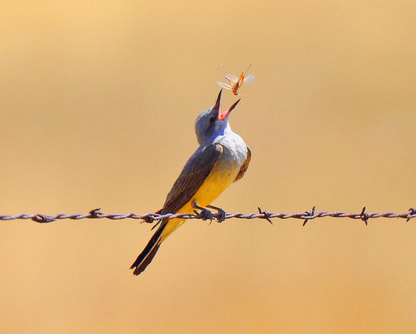Lawns aren't Natural!
 Photo courtesy of Frank R. Perez
Photo courtesy of Frank R. Perez
We are in a serious drought and this takes too much water. It requires too many chemicals that pollute our waterways. It isn't native.
What is it? Your lawn. It's time to replace your lawn.
What does this have to do with wildlife? The water and chemicals used to keep your lawn looking a pretty green have a negative impact on the environment, you and wildlife. The insecticides you use to kill one insect you don't want, kill beneficial insects as well. Did you know that homeowners use more insecticides per acre than farms?
Birds and many other forms of wildlife eat insects. A recent scientific review of the worldwide decline of insects indicates that 40 percent of insect species are declining. And a third are endangered. Insects are becoming extinct eight times faster than mammals, birds and reptiles. This is not only grave for wildlife, but for us. Insects are essential for pollination of the crops that become the food on your table. They feed many wildlife that eat the bugs you don’t want. The habitat loss and conversion of wild lands to agriculture and urbanization are the driving force behind this extinction.
Lawns take too much water. For a nice green lawn, it is recommended to water your lawn the equivalent of 1 inch per week. That is 20 minutes, three times per week. Water that we cannot afford to waste. The US Drought Monitor reported in July that 33 percent of California was under exceptional drought. But just three months before it was only 5 percent. It is getting worse fast.
What is the most grown crop in the United States? Corn? Wheat?
No, it is lawn.
If just half of every lawn in this country were converted to productive native plants, more than 20 million acres of this wasteland we call lawn could be turned into insect-supporting habitat that will feed wildlife. This would also save water, not degrade our watershed, and not put chemicals into our waterways. The 18th century European elite started this lawn craze and it is time to put the area taken up by water-wasting lawn to a better use.
Tri County Wildlife Care’s new location has a small lawn in front. We are looking at alternatives that will cut in half or eliminate this water hog and be wildlife friendly.
Native plants support more insect species than non-native plants. Use this Native Plant Finder to find native plants in your area. Replace your lawn with lupine, sunflowers, goldenrod, rabbitbrush and enjoy the colors of native plants knowing you are saving water and wildlife.
Tri County Wildlife Care, a local nonprofit started in 1994, is dedicated to the rescue and rehabilitation of our native wildlife and helping our community live in balance with wildlife. They envision a world where wildlife and people thrive together.
For more information call (209) 283-3245, or visit pawspartners.org.
What is it? Your lawn. It's time to replace your lawn.
What does this have to do with wildlife? The water and chemicals used to keep your lawn looking a pretty green have a negative impact on the environment, you and wildlife. The insecticides you use to kill one insect you don't want, kill beneficial insects as well. Did you know that homeowners use more insecticides per acre than farms?
Birds and many other forms of wildlife eat insects. A recent scientific review of the worldwide decline of insects indicates that 40 percent of insect species are declining. And a third are endangered. Insects are becoming extinct eight times faster than mammals, birds and reptiles. This is not only grave for wildlife, but for us. Insects are essential for pollination of the crops that become the food on your table. They feed many wildlife that eat the bugs you don’t want. The habitat loss and conversion of wild lands to agriculture and urbanization are the driving force behind this extinction.
Lawns take too much water. For a nice green lawn, it is recommended to water your lawn the equivalent of 1 inch per week. That is 20 minutes, three times per week. Water that we cannot afford to waste. The US Drought Monitor reported in July that 33 percent of California was under exceptional drought. But just three months before it was only 5 percent. It is getting worse fast.
What is the most grown crop in the United States? Corn? Wheat?
No, it is lawn.
If just half of every lawn in this country were converted to productive native plants, more than 20 million acres of this wasteland we call lawn could be turned into insect-supporting habitat that will feed wildlife. This would also save water, not degrade our watershed, and not put chemicals into our waterways. The 18th century European elite started this lawn craze and it is time to put the area taken up by water-wasting lawn to a better use.
Tri County Wildlife Care’s new location has a small lawn in front. We are looking at alternatives that will cut in half or eliminate this water hog and be wildlife friendly.
Native plants support more insect species than non-native plants. Use this Native Plant Finder to find native plants in your area. Replace your lawn with lupine, sunflowers, goldenrod, rabbitbrush and enjoy the colors of native plants knowing you are saving water and wildlife.
Tri County Wildlife Care, a local nonprofit started in 1994, is dedicated to the rescue and rehabilitation of our native wildlife and helping our community live in balance with wildlife. They envision a world where wildlife and people thrive together.
For more information call (209) 283-3245, or visit pawspartners.org.

